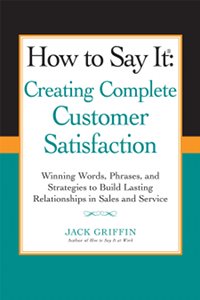Consultant addresses customer communication
Posted by Elena del Valle on March 15, 2013

How to Say It book cover
Photo: Berkley Publishing Group
In How to Say It: Creating Complete Customer Satisfaction Winning Words, Phrases and Strategies to Build Lasting Relationships in Sales and Service (Prentice Hall Press, $18) Jack Griffin sets out to share practical, results-oriented guidance for effective communication with customers through sample words, phrases, scripts, and strategies applied to real-world examples.
A communications expert and consultant to small businesses, entrepreneurs, cultural institutions, and publishers Griffin has authored other How to Say It titles including How to Say It at Work with estimated sales of 235,000. In this title, published in 2013, he outlines ways to use language to create satisfaction in the customer experience and in the sales-service cycle.
He discusses sales and customer service issues in an integrated way because he believes it reflects today’s business reality and a model that identifies customers as more than individuals to sell to but also as individuals to be satisfied. He thinks that management increasingly expects sales staff to address customer service issues that in the past might have been passed on to the customer service department. At the same time, management expects customer service staff to assist with customer purchases, particularly when it comes to upgrading, upselling, and customer communities promotions.
The 260-page softcover book is divided into 18 chapters and three parts: Speak the Language of Yes, Master the Situation, and Speak the Language of Complete Satisfaction.
The author begins by addressing communication that focuses on the customer, his or her needs and wants, ways to identify new customers, developing customer loyalty, overcoming resistance and using language to close. In Chapter 13, he shares examples of a variety of words for different occasions. In the Words of Credibility section, he recommends readers use words that develop confidence and trust and not get carried away making promises they can’t keep. Examples of such words he lists are guarantee, integrity, commitment, absolute and ethical.









